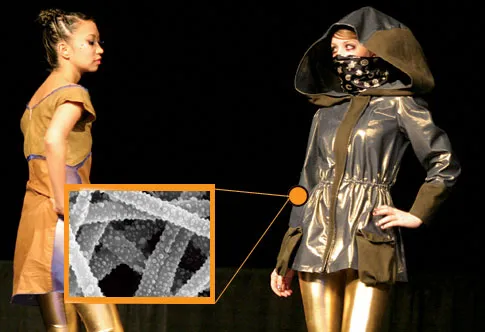
Introduction to Smart Fabrics
Fashion is no longer just about aesthetics. With the rise of smart fabrics, functionality has become a key component of modern clothing. For example, many activewear brands now incorporate spandex material into their designs, providing flexibility and comfort for a myriad of activities. Smart fabrics incorporate cutting-edge technologies that make our clothes more adaptable, responsive, and intelligent. These breakthroughs have far-reaching implications, revolutionizing how we perceive and utilize everyday wear.
The Role of Smart Textiles in Daily Wear
Smart textiles are revolutionizing everyday wear by seamlessly integrating innovative features. For instance, moisture-wicking fabrics draw sweat away from the body, keeping the wearer dry and comfortable during physical activities. Similarly, temperature-regulating textiles can adapt to body heat, ensuring optimal comfort in varying weather conditions. These advancements mean that clothes no longer serve as a barrier between your body and the elements; they actively work to improve your overall experience and well-being throughout the day.
Innovative Applications in Sports and Activewear
Advancements in fabric technology have greatly benefited sportswear. Athletes now use gear from compression fabrics that enhance performance and aid recovery. Moreover, smart textiles embedded with sensors can monitor physiological data, offering real-time performance insights. These advancements highlight how technology enhances sports attire’s functionality and effectiveness. Whether you’re a professional athlete or a weekend warrior, these innovations allow for better performance tracking, increased comfort, and improved recovery times.
Moisture-Wicking and Breathable Fabrics
Breathable fabrics, such as those used in many athletic shirts, help regulate body temperature by allowing air to circulate and sweat to evaporate. This increases comfort and improves athletic performance by maintaining optimal body conditions. Imagine running a marathon without worrying about wet, clingy fabric discomfort. That’s the magic of moisture-wicking technology, which ensures that your focus remains on your performance rather than your attire.
Compression Wear and Performance Enhancement
Compression wear is another significant advancement in sportswear. These garments increase blood flow and support muscle groups, reducing fatigue and speeding up recovery times. As a result, athletes can train harder and longer with reduced risk of injury. Compression wear offers benefits such as reduced muscle oscillation, which leads to less muscle soreness and quicker recovery. This advancement paves the way for more effective and longer training sessions, ultimately leading to better performance.
Smart Fabrics for Health and Safety
Beyond comfort and performance, smart fabrics are making significant strides in health and safety. For example, some textiles are designed to monitor vital signs, providing critical data for healthcare providers. Others can detect environmental hazards like heat or toxic gases, warning the wearer. This CNN article highlights how these applications showcase the potential life-saving capabilities of smart textiles. Think about the future possibilities where firefighters’ uniforms can detect high toxic gas levels and send alerts, potentially saving lives. Such advancements make clothing an active component in personal safety and emergency response.
Eco-Friendly Smart Fabrics
Sustainability is a growing concern in the fashion industry, and technological innovations drive eco-friendly solutions. New materials derived from recycled or biodegradable sources are being developed, reducing the environmental impact of clothing. These sustainable smart fabrics are functional and contribute to a more sustainable future. Many brands now prioritize eco-friendly fabrics to meet consumer demands for more responsible production practices. Sustainable smart fabrics, such as those made from recycled plastics or sustainably harvested bamboo, are leading the charge in reducing the fashion industry’s carbon footprint. These innovations represent a harmonious blend of eco-consciousness and cutting-edge technology, pushing the boundaries of what’s possible in a sustainable fashion.
Challenges and the Future of Fabric Technology
Despite their advantages, smart fabrics face challenges like cost and durability. However, ongoing research and development continually address these issues, paving the way for more accessible and resilient smart textiles. We can expect even more sophisticated and versatile fabric innovations as technology advances. The future might promise self-cleaning fabrics or clothing that change their properties based on climatic conditions. Addressing these challenges is crucial for ensuring these revolutionary fabrics become widely adopted and accessible.
How Consumers Can Benefit from Smart Fabrics
Consumers stand to gain significantly from integrating smart textiles into their wardrobes every day. The benefits are extensive, from enhanced comfort and improved performance in sports to better health monitoring and sustainability. As these technologies become more widespread, consumers will have access to smarter, more functional clothing. The potential savings in energy and waste reduction also make these fabrics attractive to environmentally conscious individuals. Smart fabrics can significantly reduce the need for frequent garment replacements due to wear and tear, thus offering cost savings alongside numerous other benefits. Additionally, smart textiles can drastically improve the quality of life for those with specific medical needs, thanks to their ability to monitor health indicators.
Conclusion
In conclusion, combining fashion and technology through smart fabrics transforms the clothing industry. With innovative applications in comfort, performance, health, and sustainability, these advancements are making our clothes smarter and more functional than ever before.
As technology continues to evolve, the potential for fabric innovations is limitless, promising a future where our clothing is stylish but also smart and sustainable. Imagine a future where your clothes are as smart as your phone, adapting to your environment and taking active roles in your health and well-being—this isn’t science fiction; it’s the future of fashion.

